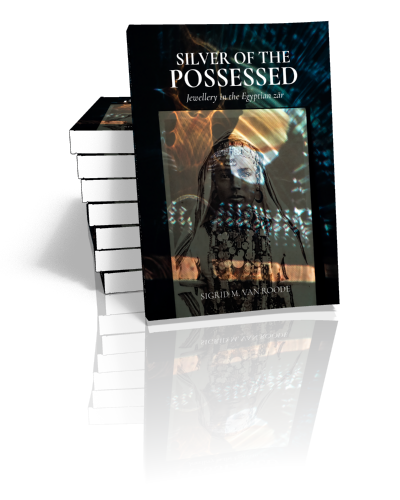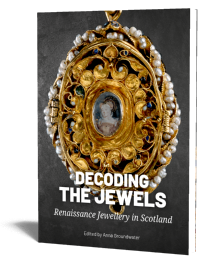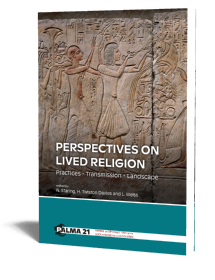Silver of the Possessed
Jewellery in the Egyptian zār
Sigrid M. van Roode | 2024

Silver of the Possessed
Jewellery in the Egyptian zār
Sigrid M. van Roode | 2024
Paperback ISBN: 9789464280722 | Hardback ISBN: 9789464280739 | Imprint: Sidestone Press Dissertations | Format: 182x257mm | 212 pp. | Language: English | 7 illus. (bw) | 155 illus. (fc) | Keywords: jewellery; ethnography; material culture; collecting; museums; ritual; possession; knowledge structures; transmission; Egypt; Ethiopia; Sudan; lived religion; history; storytelling; performance | download cover | DOI: 10.59641/z8c4w5x6y7
Read online or downloaded 2525 times
-
Digital & Online access
This is a full Open Access publication, click below to buy in print, browse, or download for free.
-
Buy via Sidestone (EU & UK)
-
Buy via our Distributors (WORLD)
For non-EU or UK destinations you can buy our books via our international distributors. Although prices may vary this will ensure speedy delivery and reduction in shipping costs or import tax. But you can also order with us directly via the module above.
UK international distributor
USA international distributor
-
Bookinfo
Paperback ISBN: 9789464280722 | Hardback ISBN: 9789464280739 | Imprint: Sidestone Press Dissertations | Format: 182x257mm | 212 pp. | Language: English | 7 illus. (bw) | 155 illus. (fc) | Keywords: jewellery; ethnography; material culture; collecting; museums; ritual; possession; knowledge structures; transmission; Egypt; Ethiopia; Sudan; lived religion; history; storytelling; performance | download cover | DOI: 10.59641/z8c4w5x6y7
Read online or downloaded 2525 times

We will plant a tree for each order containing a paperback or hardback book via OneTreePlanted.org.
In the 19th century an African possession cult called zār arrived in Egypt and became hugely popular. Jewellery formed an integral part of this cult, and silver pendants with images of spirits started to appear in the early 20th century. And there is more: zār also used beaded jewellery as well as a wide range of other jewels.
Currently, jewellery items with spirit images are sought-after collectors’ items, present in collections of both private collectors and museums. These collections also hold a wide variety of other pieces called ‘zār jewellery’, and many jewellery pieces labelled ‘zār’ are available online. But what is ‘zār jewellery’, exactly?
With collectors, curators, historians and ethnographers in mind, Silver of the Possessed places jewellery of the Egyptian zār in its cultural and historical context. A catalogue of previously unpublished jewellery in private collections illustrates the changes in this jewellery over the course of nearly a century, while the book itself addresses Egyptian zār jewellery from multiple angles.
First, it analyses how our current understanding of this jewellery has evolved through collecting and publishing. Examining its cultural background in African possession cults results in a new insight of the many roles jewellery played in zār, observing jewellery as a financial asset allows us to grasp its implications for household economy dynamics, while looking at jewellery in a diachronic perspective may even reveal changes in the ritual itself. Finally, this study explores its potential as an actual historic source: these jewellery items shed light on the world view of their wearers, and as such form an unexpected additional source for late 19th and early 20th century Egypt.
Preface
Chapter 1 Introduction
1.1 Aims and approach
1.2 Sources: the sample collection
1.3 Sources: literature
1.4 Structure of this thesis
Chapter 2 Spirits and women in Egypt
2.1 Origins and dissemination of zār
2.2 Spirit engagement and the world of women
2.3 zār
Chapter 3 Collected Objects
3.1 The curious case of the missing jewellery: published objects
3.2 To have and to hold: collected objects
3.3 Disassociation from primary life
Chapter 4 Living Objects
4.1 Challenges in interpreting decontextualised objects
4.2 Humans, spirits and objects
4.3 zār jewellery in everyday life
Chapter 5 Historic Objects
5.1 Materialised memory
5.2 Three case studies
5.3 The sample collection as a historic source
Chapter 6 The world of zār jewellery
6.1 The people of zār
6.2 Long-term changes in zār
6.3 The origin of the Egyptian zār power objects
Chapter 7 Conclusions
Bibliography
Appendix 1 The costs of a zār: a case study from 1913
Appendix 2 Glossary of terms
Acknowledgements
Catalogue

Dr. Sigrid M. van Roode
Sigrid van Roode is an archeologist, ethnographer and jewellery historian. Her main field of expertise is jewellery from North Africa and Southwest Asia, as well as archaeological and archaeological revival jewellery. She has authored several books on jewellery, such as Desert Silver (2017) and Silver & Frankincense (2020). With her consultancy Bedouin Silver, she researches jewellery collections for both museums and private collections, teaches courses and curates exhibitions.
Abstract:
In the 19th century an African possession cult called zār arrived in Egypt and became hugely popular. Jewellery formed an integral part of this cult, and silver pendants with images of spirits started to appear in the early 20th century. And there is more: zār also used beaded jewellery as well as a wide range of other jewels.
Currently, jewellery items with spirit images are sought-after collectors’ items, present in collections of both private collectors and museums. These collections also hold a wide variety of other pieces called ‘zār jewellery’, and many jewellery pieces labelled ‘zār’ are available online. But what is ‘zār jewellery’, exactly?
With collectors, curators, historians and ethnographers in mind, Silver of the Possessed places jewellery of the Egyptian zār in its cultural and historical context. A catalogue of previously unpublished jewellery in private collections illustrates the changes in this jewellery over the course of nearly a century, while the book itself addresses Egyptian zār jewellery from multiple angles.
First, it analyses how our current understanding of this jewellery has evolved through collecting and publishing. Examining its cultural background in African possession cults results in a new insight of the many roles jewellery played in zār, observing jewellery as a financial asset allows us to grasp its implications for household economy dynamics, while looking at jewellery in a diachronic perspective may even reveal changes in the ritual itself. Finally, this study explores its potential as an actual historic source: these jewellery items shed light on the world view of their wearers, and as such form an unexpected additional source for late 19th and early 20th century Egypt.
Contents
Preface
Chapter 1 Introduction
1.1 Aims and approach
1.2 Sources: the sample collection
1.3 Sources: literature
1.4 Structure of this thesis
Chapter 2 Spirits and women in Egypt
2.1 Origins and dissemination of zār
2.2 Spirit engagement and the world of women
2.3 zār
Chapter 3 Collected Objects
3.1 The curious case of the missing jewellery: published objects
3.2 To have and to hold: collected objects
3.3 Disassociation from primary life
Chapter 4 Living Objects
4.1 Challenges in interpreting decontextualised objects
4.2 Humans, spirits and objects
4.3 zār jewellery in everyday life
Chapter 5 Historic Objects
5.1 Materialised memory
5.2 Three case studies
5.3 The sample collection as a historic source
Chapter 6 The world of zār jewellery
6.1 The people of zār
6.2 Long-term changes in zār
6.3 The origin of the Egyptian zār power objects
Chapter 7 Conclusions
Bibliography
Appendix 1 The costs of a zār: a case study from 1913
Appendix 2 Glossary of terms
Acknowledgements
Catalogue

Dr. Sigrid M. van Roode
Sigrid van Roode is an archeologist, ethnographer and jewellery historian. Her main field of expertise is jewellery from North Africa and Southwest Asia, as well as archaeological and archaeological revival jewellery. She has authored several books on jewellery, such as Desert Silver (2017) and Silver & Frankincense (2020). With her consultancy Bedouin Silver, she researches jewellery collections for both museums and private collections, teaches courses and curates exhibitions.
-
Digital & Online access
This is a full Open Access publication, click below to buy in print, browse, or download for free.
-
Buy via Sidestone (EU & UK)
-
Buy via our Distributors (WORLD)
For non-EU or UK destinations you can buy our books via our international distributors. Although prices may vary this will ensure speedy delivery and reduction in shipping costs or import tax. But you can also order with us directly via the module above.
UK international distributor
USA international distributor
- Browse all books by subject
-
Search all books

We will plant a tree for each order containing a paperback or hardback book via OneTreePlanted.org.
You might also like:
© 2025 Sidestone Press KvK nr. 28114891 info@sidestone.nl Privacy policy Sidestone Newsletter Terms and Conditions (Dutch)








